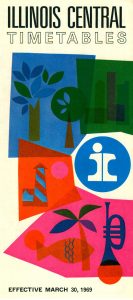 The Transportation Library is thrilled to make the John A. Swider Timetable Collection available to researchers. The collection comprises 919 timetables from bus and rail operators in the U.S. and Canada, dating from 1880 to 2006, with the majority issued between the 1930s and the 1990s. Special focuses of the collection are on the Chicago metropolitan area and on travel to the San Francisco, Chicago, and New York’s World’s Fairs.
The Transportation Library is thrilled to make the John A. Swider Timetable Collection available to researchers. The collection comprises 919 timetables from bus and rail operators in the U.S. and Canada, dating from 1880 to 2006, with the majority issued between the 1930s and the 1990s. Special focuses of the collection are on the Chicago metropolitan area and on travel to the San Francisco, Chicago, and New York’s World’s Fairs.
Timetables were meant to be ephemeral documents, discarded when schedules changed, stations were added or removed, or railroads purchased or rebranded. They served important functions during their time, providing passengers with travel times, station locations, and sometimes more: the chance to dream about far-flung destinations, and the excitement of the journey surrounding rail travel. Today, timetables provide valuable historical documentation for researchers: all of the information that once helped travelers reach their destinations helps us to understand the traveler’s experience and the corporate history of transportation companies.
Researchers can browse the collection by issuing agency or company via the online finding aid. This collection is available to the public on an appointment-only basis. Please contact the Northwestern University Transportation Library to make an appointment, or for more information.
A selection of timetables is highlighted below.
Amtrak Timetable – May 1, 1971
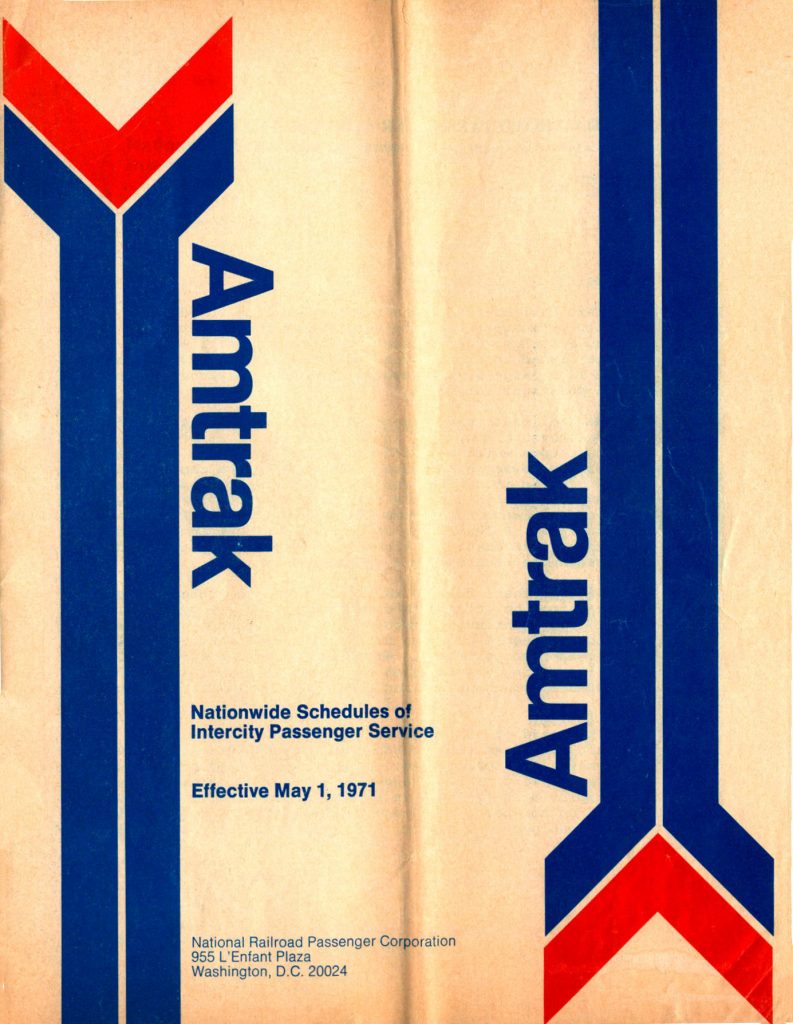 Amtrak began service on May 1, 1971. A quasi-public agency created the previous year with the Rail Passenger Service Act, it initially served 43 states with 21 routes across the country. The name Amtrak came from a blending of the words “American” and “track,” and the firm of Lippincott & Marguiles created an identity system for the new company, which was featured prominently on the timetable shown here — the first to have been produced for Amtrak.
Amtrak began service on May 1, 1971. A quasi-public agency created the previous year with the Rail Passenger Service Act, it initially served 43 states with 21 routes across the country. The name Amtrak came from a blending of the words “American” and “track,” and the firm of Lippincott & Marguiles created an identity system for the new company, which was featured prominently on the timetable shown here — the first to have been produced for Amtrak.
The timetable included a letter from Chairman of the Board David W. Kendall, addressed to the American Traveler, introducing the new national system of rail passenger service. The new corporation sought to make the system attractive to all travelers through refurbishment of terminals and equipment, innovative ticketing improvements, and other service improvements.
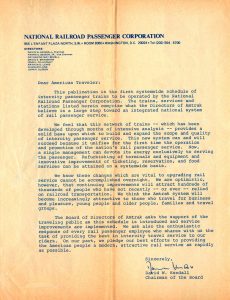
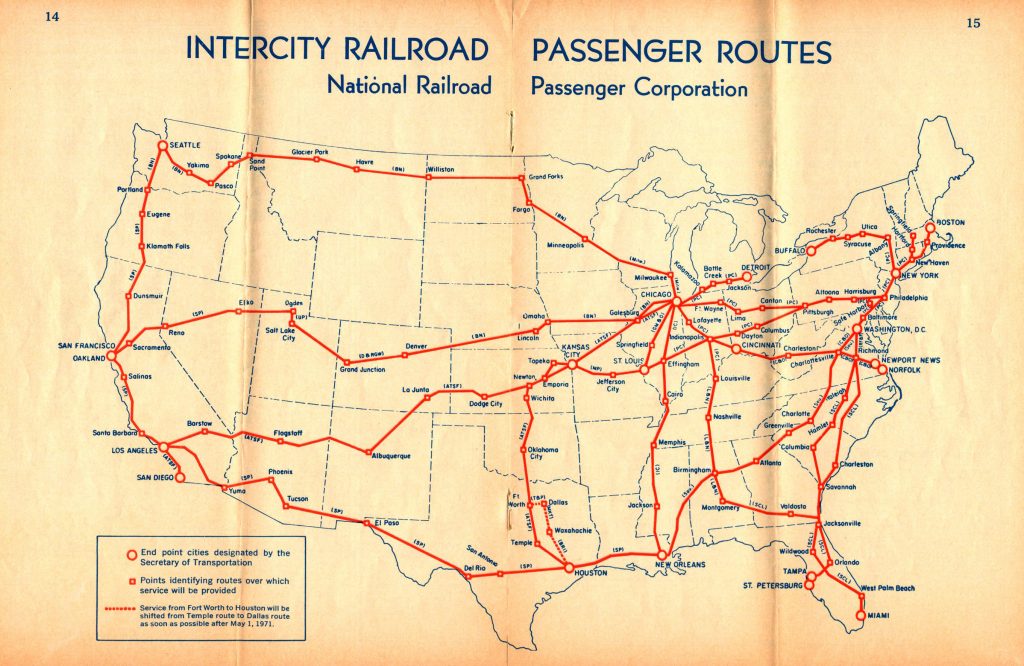
New York Central Railroad Timetable – May 13, 1940
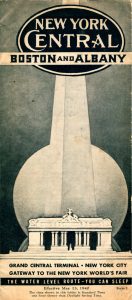 Railroads appealed to passengers traveling to World’s Fairs with timetables that featured the fairs’ attractions — here, the New York Central featured the 1939-1940 New York World’s fair on its timetable for May 13, 1940. The railroad’s Water Level Route was relatively flat (hence the caption “you can sleep” on the timetable’s cover). It also followed bodies of water along the route, providing scenic views for passengers on their way to the Fair or otherwise.
Railroads appealed to passengers traveling to World’s Fairs with timetables that featured the fairs’ attractions — here, the New York Central featured the 1939-1940 New York World’s fair on its timetable for May 13, 1940. The railroad’s Water Level Route was relatively flat (hence the caption “you can sleep” on the timetable’s cover). It also followed bodies of water along the route, providing scenic views for passengers on their way to the Fair or otherwise.
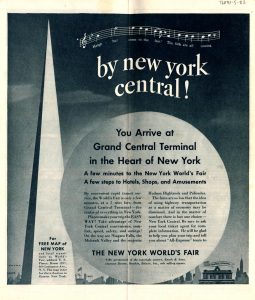 The New York Central carried passengers into Grand Central Terminal, which it promoted as just a 5-cent fare by rapid transit from the World’s Fair. An early sign of the coming dominance of the highway system is also shown here, in the claim that “fares are so low that the idea of using highway transportation as a matter of economy may be dismissed.” Interestingly, it was at the 1939-1940 New York World’s Fair that the General Motors Futurama pavilion introduced fairgoers to a future of cities and transportation focused around a network of highways.
The New York Central carried passengers into Grand Central Terminal, which it promoted as just a 5-cent fare by rapid transit from the World’s Fair. An early sign of the coming dominance of the highway system is also shown here, in the claim that “fares are so low that the idea of using highway transportation as a matter of economy may be dismissed.” Interestingly, it was at the 1939-1940 New York World’s Fair that the General Motors Futurama pavilion introduced fairgoers to a future of cities and transportation focused around a network of highways.
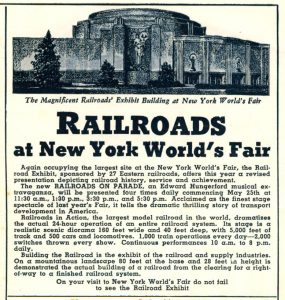 Included in the advertising section of this timetable is a section highlighting railroads at the fair. The railroad exhibit occupied the largest site at the fair and included a four-times-daily extravaganza titled Railroads on Parade, which told the story of the development of transportation in the United States. The fair also featured the largest model railroad int he world, which boasted 5,000 feet of track and 500 cars and locomotives, with 1,000 operations daily. An exhibit called Building the Railroad demonstrated, from the clearing of the right-of-way to the completion of a railway system, the actual building of a railroad on a platform 28 feet high and 80 feet at the base.
Included in the advertising section of this timetable is a section highlighting railroads at the fair. The railroad exhibit occupied the largest site at the fair and included a four-times-daily extravaganza titled Railroads on Parade, which told the story of the development of transportation in the United States. The fair also featured the largest model railroad int he world, which boasted 5,000 feet of track and 500 cars and locomotives, with 1,000 operations daily. An exhibit called Building the Railroad demonstrated, from the clearing of the right-of-way to the completion of a railway system, the actual building of a railroad on a platform 28 feet high and 80 feet at the base.
Chicago, North Shore & Milwaukee Railroad Timetable – December 3, 1939
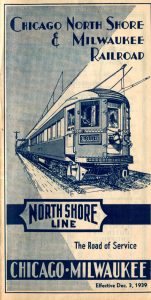 The Chicago, North Shore & Milwaukee’s Railroad’s North Shore Line was an all-electric railroad, in operation from 1916 to 1963. The timetable published on December 3, 1939 included listings for passenger rail service connecting Chicago with the suburbs of the North Shore, extending up to Kenosha, Racine, and Milwaukee. In addition to the line’s regular rail service, the North Shore Line carried passengers on motor coaches, with destinations including Waukegan, Zion, and Winthrop H
The Chicago, North Shore & Milwaukee’s Railroad’s North Shore Line was an all-electric railroad, in operation from 1916 to 1963. The timetable published on December 3, 1939 included listings for passenger rail service connecting Chicago with the suburbs of the North Shore, extending up to Kenosha, Racine, and Milwaukee. In addition to the line’s regular rail service, the North Shore Line carried passengers on motor coaches, with destinations including Waukegan, Zion, and Winthrop H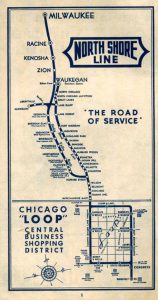 arbor. Famously, from 1941 until 1963, the railroad offered service on its Electroliner trains, two sets of four striking teal and orange coaches, operating at speeds up to 90mph and offering passengers a luxurious, fully air-conditioned ride.
arbor. Famously, from 1941 until 1963, the railroad offered service on its Electroliner trains, two sets of four striking teal and orange coaches, operating at speeds up to 90mph and offering passengers a luxurious, fully air-conditioned ride.
The timetable came in at over 40 pages, with extensive information that included baggage checking, children’s fares, freight services, hotel ticket offices, and Pullman reservations, as well as the usual schedule information and maps.
The North Shore Line is the subject of several books in the collection of the Transportation Library. Interested researchers can visit to learn more about this fascinating part of rail history.
